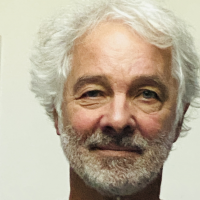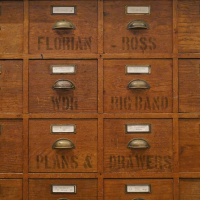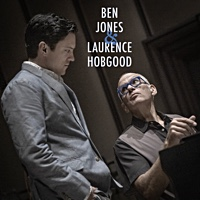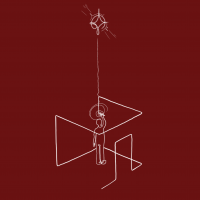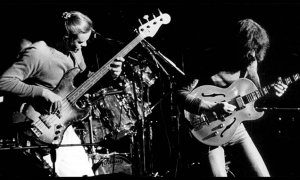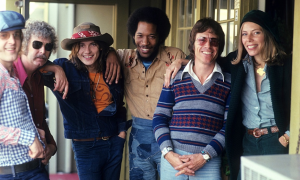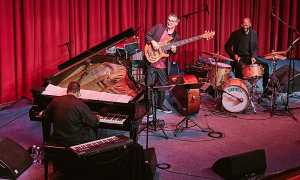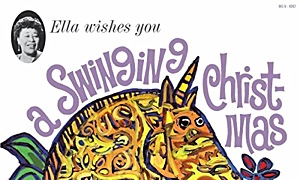Home » Jazz Articles » Profile » Rita Payés At Jazz à La Villette, In Paris
Rita Payés At Jazz à La Villette, In Paris
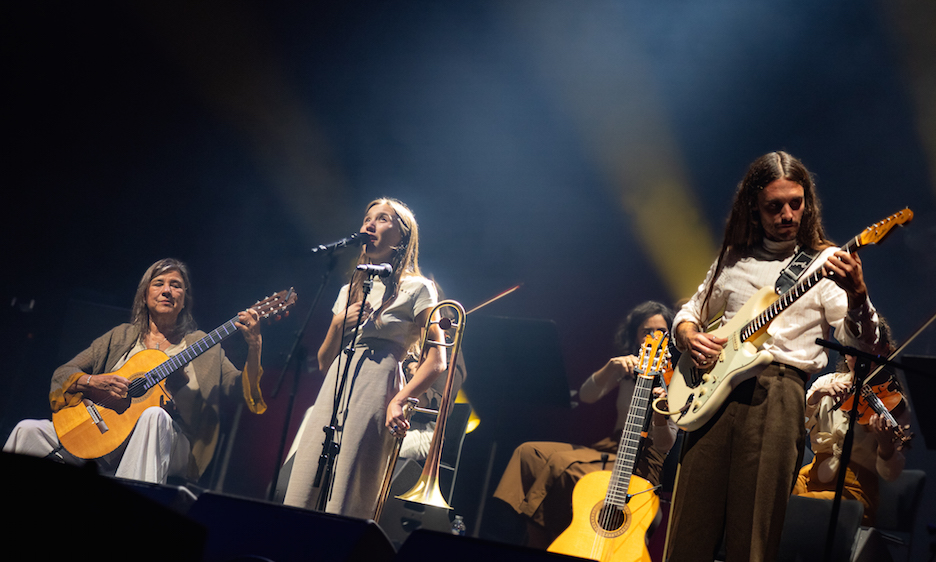
Courtesy Maxime Guthfreund
The first thing that comes to mind is the heart-clenching power of whatever she sings. You are overcome by a sadness you didn't know you had—a deep and shapeless sadness, buried unidentified tears, a hidden reservoir of sorrow.
This performer is in a category of her own, pursuing her personal musical projects with a singularity that has become her signature. Born to a family of musicians, she sings and writes in Catalan, Castilian Spanish, and Portuguese—and sometimes in English, having spent her adolescence interpreting standard jazz songs (still on YouTube).
An experienced member of the Sant Andreu Jazz Band from Barcelona since age 13, she had already made a considerable splash in the jazz community when she decided to change course at 19, with her excellent (and professional) classical guitarist mother, Elisabeth Roma. The two found common ground over a repertoire of traditional pieces, bossa novas, and boleros, all of which Payés sings with a voice that breaks all emotional barriers, making way for the full, round, and deep sound of her trombone straight to your heart. These exceptional performers toured much of Europe and beyond with the tracks from their first album, Imagina (2019, Self-Published).
On the second, Como la piel (2021, self-published), they were joined by other musicians, and Payés introduced a number of her own compositions, like "Nunca vas a comprender," a clip with 8 million views on YouTube, and "Eu desespero," which she wrote in Portuguese. Again, an international tour followed, with the occasional invitation to local gigs such as the Köln WDR Big Band—a must-see concert online that leaves no doubt about Payés' jazz roots.
She is now giving her last concerts based on her third and most recent release, De camino al camino (Sony España, 2024). It features mostly her own works, where her style shifts from traditional forms to more intricate arrangements, with clear jazz inflections and a string quartet that she orchestrates herself ("Se transformará," "Benvingudes," "Alma en vilo" by Payés' brother Eudald, who plays trumpet on the track).
She is well known across Europe and also in Latin America (Colombia, Mexico). Her appearance at NPR's Tiny Desk Concert in October 2024 made a huge impression and won her an even larger following, notably on Instagram.
Her recordings have spanned a period of change—that of a very young woman becoming a grown one. One can't help but notice how her vocal tone has changed significantly in the process. The youthful timbre of Imagina gave way to a somewhat somber ring on "De camino al camino," closer to what you'd expect from the mother of two. On Como la piel, the middle record, you can literally hear the change happening.
Some critics say she is going about her career very slowly. This feeling of non-speed may emanate from her very calm person, but in terms of productions, collaborations, and concerts, her accomplishments over such a short period (while giving birth twice) are impressive—and we know she's already working on her next moves. She's taking her time all right, but she apparently never stops. (Reread "The Tortoise and the Hare.")
The Concert
So much for context. Knowing all this, on the evening of the Paris concert, I was approaching the Cité de la musique in Paris with some expectations, and I was not disappointed.The first part of the evening was handled by British-Grenadian singer Ala.ni, unfolding her own original pieces with a spectacular voice and engaging warmly with the crowd.
But when Payés and her imposing ensemble (Elisabeth Roma and Pol Batlle on guitars, Horacio Fumero on double bass, Juan Rodriguez Berbín on percussion and drums, and the string quartet—Marina Arrufat Grau, Paula Sanzalas, Nina Sunyer Vidal, and Irma Bau Rubinat) took over, she didn't utter a word. She started a slow trombone solo introduction, with a delay effect that made her accompany herself, and was eventually joined by the strings for the instrumental "Intro," the first track of De camino al camino. She followed with "El cervatillo," a lively piece whose lyrics inspired the album title, and "Si entras tú," a slow and dreamily arranged love ballad dedicated to the second guitarist, Pol Batlle, father of her two daughters.
Only then did she acknowledge the audience, which was already reacting warmly to each number. She spoke in hesitant English (later in Castilian), knowing little or no French, explaining that the show would be based on tracks from her latest release. And that's mostly what happened, with the exception of a traditional medley recorded on Como la piel ("Caricias/Esta Montaña de enfrente"), as well as "Quién lo diría" (an early song by Payés), an old Argentine tango ("Niebla del Riachuelo"), and the invitation to the stage of a young and impressive French guitarist, Antoine Boyer, for a very emotional rendition of the jazz standard "Like Someone in Love," notably popularized by Ella Fitzgerald. This impromptu was followed by the appearance of Boyer's Korean harmonicist wife, Yeore Kim, who joined with a stunning solo in Payés' next piece, "Quién lo diría." Most songs were played by the whole band, but some more intimate duets were also performed with Roma or Fumero, the virtuoso bassist. Among all musicians on stage, Juan Rodriguez Berbín deserves a special mention as the master of all things percussive (with a considerable array of sound-ringing objects being used in the process), on which much of this music depends for its dynamics—Juan is also the producer of Payés' last two albums.
The fifteenth and last piece was the bouncing "No digo que no" (or "Vaca y pollo") as the sole encore—which was a relief in this country where the audience often insists on bringing artists back endlessly, even when they are visibly exhausted, and Payés' set is certainly physically demanding. She often closes her concerts with this piece, inviting the crowd to join in the whistling finale as the musicians all come forward for a collective bow: whistles and animal sounds filled the air.
The Cité de la musique concert hall was jam-packed. With a capacity of only 650, tickets had sold out months in advance—even though Payés is not so famous outside the Hispanosphere. This relatively intimate venue was cooler and cozier than the multi-thousand-seat halls Payés is used to. But the audience was hot all right. All in all, this concert, widely reposted on social networks, will remain a memorable event.
Some Background
In the early videos, Elisabeth and Payés appear as an entwined system. Their identity is the perfectly balanced sound of their instruments, including the singer's voice. Naturally, you think of Elisabeth accompanying Payés, but you can also see Payés as a byproduct of Elisabeth's performance. This systemic imbrication is a whole and can be regarded from different perspectives.Payés wouldn't be Payés without Roma. I'm not talking about her upbringing, through which the mother-daughter relationship necessarily played a major part—along with her musician father's (and brothers'), probably. I'm referring to the style of Payés' interpretations and compositions, which result from the collision between the jazz and classical realms of music. The incredibly rich vocabulary of this guitarist (a testimony to the fact that the guitar originates from Spain) serves as the ideal vehicle for Payés' artistry, though usually understated. Without her, let's say she would be a different Payés, maybe a renowned singer-trombonist circulating the international jazz scene successfully, as she has demonstrated, but probably not the bolero singer who breaks your heart every other bar and has you melt down to a little pool of sorrow.
The first albums are truly duets, and Elisabeth's assurance and experience were crucial in shaping their inimitable style. But her comment (somewhere on Instagram) about Payés, her work, and her vision is full of humility and admiration. In truth, she's her biggest fan: Rita is an artist who particularly moves me. She is a brave woman, eager to savor everything life has to offer, and this makes her flexible as a musician and as a person. She is a trombonist-singer or vice versa; I don't think even she knows. We can find her sharing popular Latin American songs, playing in a big band alongside other artists as a sideman (sidewoman, no?), enjoying bossa nova, participating in a jazz combo, dabbling in classical or flamenco, immersed in her songs...
Experiencing music by her side is wonderful. Rita is welcoming on stage, she makes you feel good, and she surrounds herself with good musicians and good people. People often ask me what it's like to play with my daughter, and obviously I love it, but above all, it makes me grow, and for me it's an honor to participate in her concerts. (Translated from Catalan, Festival Jazz Barcelona)
This trombone-voice precedence question is not trivial: at length, you get the image of one instrument with two distinct but enmeshed voices. For example, sometimes Payés uses glissandi in her singing as if with her trombone slide, escaping the tonal hold and adding an oriental (or Andalusian) touch to the melody. And when she reaches for pedal notes on the horn, you are reminded of the exceptionally low tones of her voice—her mezzo-soprano extends into the contralto range. But the more significant, underlying resemblance between the two is more difficult to pin down. It has something to do with emotion and a similarity between the voice and the instrument in the way it is rendered.
The traditional/jazz dichotomy is another interesting issue. In folk or traditional music, chords are usually relatively simple, and musicians, in their solos, just follow the main key of the song. But in jazz, as we know, chords are more elaborate and tend to bend the key with rich alterations—improvising in this context requires the musician to change scale with each new chord, which accounts for the compelling melodious effect. Our trombonist typically jazzes up her traditional repertoire in this way.
There is also a very uncommon freedom of structure in her compositions. Instead of a typical chorus/verse alternation on a single beat throughout, she often makes use of many different melodic lines that unfold somewhat like a recitative ("Si entras tú," "Tantas cosas"—note the dark string introduction). Rhythm changes, like in "Eu desespero," are also frequent. This composer literally composes, like a painter, a musical landscape, with all the options at her disposal.
Finally, the persona of Payés is very endearing. To this day, her early "Nunca vas a comprender" accumulates the most views on her YouTube channel: the piece is beautiful, catchy, and touching, but the image of the young woman in the meadow with her long hair let down and her hazel-brown eyes, switching from guitar to trombone and back, certainly plays a role in the attraction, though you can tell she tends to downplay that asset: Payés is about music, only music.
The Payés Experience
There is a growing fascination around Payés, and when you listen to her over the last six years, it's no wonder. You feel the pull. Why is that?
The first thing that comes to mind is the heart-clenching power of whatever she sings. You are overcome by a sadness you didn't know you had—a deep and shapeless sadness, buried unidentified tears, a hidden reservoir of sorrow.
Emotion also rises from the apparent perfection of what you are hearing: the modulated timbre, the pitch, the diction. The guitar of Roma, especially present on the first two albums, is strikingly creative and dexterous. And Payés' trombone is distilled artistry: no frills, no unnecessary virtuosity, the straight (and recognizable) sound, the right note in the right place. That simplicity gets to you. The whole experience seems so accurate, flawless, controlled with infinite precision, while sounding so easy and natural. When you encounter such a fit, yes, "perfection" comes to mind. It is notable that, as she has welcomed more musicians onto her bandwagon, she has managed to uphold the same demanding standards without betraying her initial aim.
Also, the shaping of her vocal delivery is a very important component of her artistry. I don't speak Catalan, Castilian, or Portuguese. Therefore, I only hear sounds, with no semantic reference. I do not know how speakers of those languages react (although I can see that she has an immense following among them, and automatic translators have allowed me to appreciate the quality of her lyrics), but from my point of view, the languages she uses are just like musical instruments.
A musical instrument is characterized by a set of recognizable sounds that may vary along a palette of nuances, mainly attack and timbre variations. Musicians have relative control over those: more control when they are physically close to the production of sound (winds, strings), and less when they are more remote, like with the piano.
My case is that a language you don't understand also comes across as a set of attacks (consonants) and timbres (vowels). We non-Castilian/Catalan/Portuguese speakers hear Payés' singing as if she were playing a particular instrument. And there is mastery here, in her diction and prosody—a quality of linguistic nature that becomes musical outside the consensus of a shared language. In other words, Payés plays the language of the lyrics.
Her diction relates to musical phrasing. Listen to those barely audible S's at the end of a verse, and beware of the rolling R's that come hurling at you. And her tone is all but linear, varying frequently along a single verse. If you speak the languages she sings in, maybe you don't really notice that linguistic music—that almost percussive string of mouth sounds that's so fascinating to us foreigners—or maybe you do?
From what I hear, listening to other singers of the same cultural background, Payés' rendition singles her out. She is not only a singer but something close to a theater actor, a worder, a poem reader. She mentions it herself somewhere, about her lyric writing: "I sometimes choose the words for their sound rather than for their meaning." Welcome to Payés' poetry—words come out as sounds that refer to a dictionary one may not have, just like musical notes that bear no definition.
In Short
Payés is not simply a very intelligent assembly of artistic choices, a clever scheme. She is the product of an exceptional alignment of planets that could not have been consciously or rationally planned. That is a gift of life, but she is very intelligently and courageously (as Elisabeth puts it) making the most of it, taking the time to protect her own family life, preserving her sincerity, modesty, and pure emotional renditions of her music. Thank God for that.However, it is somewhat contradictory that, while resisting public life by clinging to her family circle (Mom, sometimes Dad, brothers, partner, and of course "las niñas," whom she takes on tour with her) and close friends, she still allows significant intimacy to seep through on the networks where tens of thousands of fans await bits of daily life. This contradiction is underlined by the fact that she publicly criticizes that situation, where an artist cannot concentrate on art alone but must endure the constant pressure of the hungry network eye. We can only agree and hope that her established reputation could now allow her to stand back a bit from the crowd.
In concert, the shorter, certainly lighter, and usually younger (compared to her fellow musicans) Payés is discreetly leading. Her graceful movements also set the rhythm as she slowly glides around the stage center, barefoot, sometimes rising on her toes for a note. Make no mistake: it's her music they're playing, whether her own songs or her arrangements of others, which she very much makes her own through highly personal vocal interpretations. She knows what she wants, and she is demanding, although apparently also open to suggestions and welcoming of the creativity of her band. She loves to make music with people, to improvise on the fly, or to take supporting roles in others' projects. She seems open to numerous propositions. But on her albums and concerts, there's no question that this little lady, charming and apparently forever smiling, is the boss.
When she sings, she often seems on the verge of tears. But offstage, as she appears online, it looks as if she's instead always laughing. "Joy" is a word you would like to pin on her, for joy is not pleasure: it does not oppose sorrow; it goes hand in hand with sadness. Joy, "alegría," is about beauty, and beauty is what Rita Payés will fight for.
Tags
PREVIOUS / NEXT
Support All About Jazz
 All About Jazz has been a pillar of jazz since 1995, championing it as an art form and, more importantly, supporting the musicians who make it. Our enduring commitment has made "AAJ" one of the most culturally important websites of its kind, read by hundreds of thousands of fans, musicians and industry figures every month.
All About Jazz has been a pillar of jazz since 1995, championing it as an art form and, more importantly, supporting the musicians who make it. Our enduring commitment has made "AAJ" one of the most culturally important websites of its kind, read by hundreds of thousands of fans, musicians and industry figures every month.

